Canon XC10 vs Olympus E-PL9
The Canon XC10 and the Olympus PEN E-PL9 are two digital cameras that were officially introduced, respectively, in April 2015 and February 2018. The XC10 is a fixed lens compact, while the E-PL9 is a mirrorless interchangeable lens camera. The cameras are based on an one-inch (XC10) and a Four Thirds (E-PL9) sensor. The Canon has a resolution of 12 megapixels, whereas the Olympus provides 15.9 MP.
Below is an overview of the main specs of the two cameras as a starting point for the comparison.

Check XC10 offers at
ebay.com

Check E-PL9 offers at
ebay.com
Going beyond this snapshot of core features and characteristics, what are the differences between the Canon XC10 and the Olympus PEN E-PL9? Which one should you buy? Read on to find out how these two cameras compare with respect to their body size, their imaging sensors, their shooting features, their input-output connections, and their reception by expert reviewers.
Body comparison
An illustration of the physical size and weight of the Canon XC10 and the Olympus E-PL9 is provided in the side-by-side display below. The two cameras are presented according to their relative size. Three consecutive perspectives from the front, the top, and the back are available. All width, height and depth measures are rounded to the nearest millimeter.
The E-PL9 can be obtained in four different colors (black, brown, blue, white), while the XC10 is only available in black.
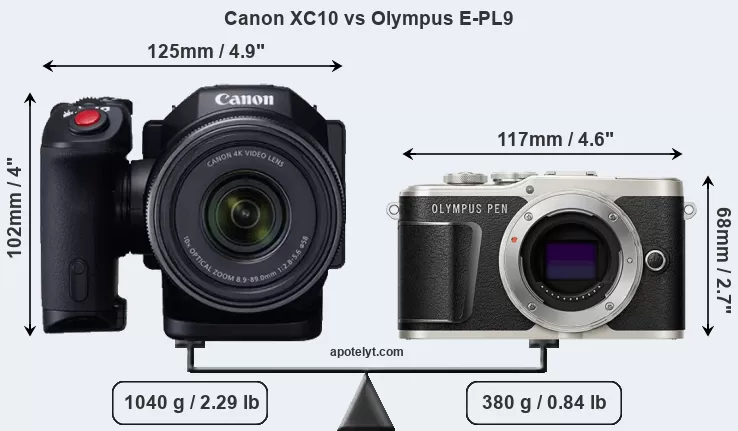
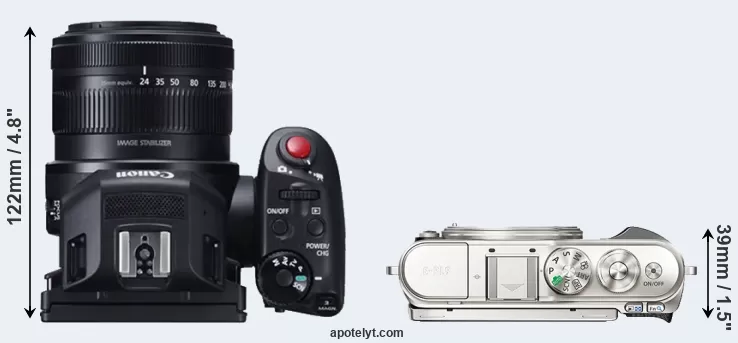
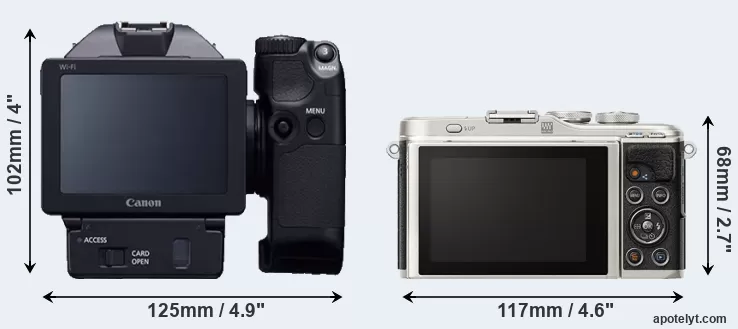
If the front view area (width x height) of the cameras is taken as an aggregate measure of their size, the Olympus E-PL9 is considerably smaller (38 percent) than the Canon XC10. In this context, it is worth noting that neither the XC10 nor the E-PL9 are weather-sealed.
The above size and weight comparisons are to some extent incomplete and possibly misleading, as the XC10 has a lens built in, whereas the E-PL9 is an interchangeable lens camera that requires a separate lens. Attaching the latter will add extra weight and bulk to the setup. You can compare the optics available for the E-PL9 and their specifications in the Micro Four Thirds Lens Catalog.
Concerning battery life, the XC10 gets 370 shots out of its Canon LP-E6N battery, while the E-PL9 can take 350 images on a single charge of its Olympus BLS-50 power pack. The power pack in the XC10 can be charged via the USB port, so that it is not always necessary to take the battery charger along when travelling.
The table below summarizes the key physical specs of the two cameras alongside a broader set of comparators. In case you want to display and compare another camera duo, you can use the CAM-parator app to select your camera combination among a large number of options.

| # | Camera Model |
Camera Width |
Camera Height |
Camera Depth |
Camera Weight |
Battery Life |
Weather Sealing |
Camera Launch |
Launch Price (USD) |
Street Price |
|
|---|---|---|---|---|---|---|---|---|---|---|---|
| 1. | Canon XC10 | 125 mm | 102 mm | 122 mm | 1040 g | 370 | n | Apr 2015 | 2,499 | ebay.com | |
| 2. | Olympus E-PL9 | 117 mm | 68 mm | 39 mm | 380 g | 350 | n | Feb 2018 | 599 | ebay.com | |
| 3. | Canon G7 X Mark II | 106 mm | 61 mm | 42 mm | 319 g | 265 | n | Feb 2016 | 699 | ebay.com | |
| 4. | Canon G5 X | 112 mm | 76 mm | 44 mm | 353 g | 210 | n | Oct 2015 | 799 | ebay.com | |
| 5. | Canon G9 X | 98 mm | 58 mm | 31 mm | 209 g | 220 | n | Oct 2015 | 529 | ebay.com | |
| 6. | Canon G1 X Mark II | 116 mm | 74 mm | 66 mm | 553 g | 240 | n | Feb 2014 | 799 | ebay.com | |
| 7. | Canon G7 X | 103 mm | 60 mm | 40 mm | 304 g | 210 | n | Sep 2014 | 699 | ebay.com | |
| 8. | Canon SX60 | 128 mm | 93 mm | 114 mm | 650 g | 340 | n | Sep 2014 | 549 | ebay.com | |
| 9. | Fujifilm X30 | 119 mm | 72 mm | 60 mm | 423 g | 470 | n | Aug 2014 | 599 | ebay.com | |
| 10. | Nikon P900 | 140 mm | 103 mm | 137 mm | 899 g | 360 | n | Mar 2015 | 599 | ebay.com | |
| 11. | Olympus E-PL10 | 117 mm | 68 mm | 39 mm | 380 g | 350 | n | Oct 2019 | 599 | ebay.com | |
| 12. | Olympus E-M10 III | 122 mm | 84 mm | 50 mm | 410 g | 330 | n | Aug 2017 | 649 | ebay.com | |
| 13. | Olympus E-PL8 | 115 mm | 67 mm | 38 mm | 357 g | 350 | n | Sep 2016 | 549 | ebay.com | |
| 14. | Olympus E-M10 II | 120 mm | 83 mm | 47 mm | 390 g | 320 | n | Aug 2015 | 649 | ebay.com | |
| 15. | Olympus E-M10 | 119 mm | 82 mm | 46 mm | 396 g | 320 | n | Jan 2014 | 699 | ebay.com | |
| 16. | Panasonic FZ2500 | 138 mm | 102 mm | 135 mm | 915 g | 350 | n | Sep 2016 | 1,199 | amazon.com | |
| 17. | Panasonic LX100 | 115 mm | 66 mm | 55 mm | 393 g | 300 | n | Sep 2014 | 899 | ebay.com | |
| Note: Measurements and pricing do not include easily detachable parts, such as add-on or interchangeable lenses or optional viewfinders. | |||||||||||
Any camera decision will naturally be influenced heavily by the price. The retail prices at the time of the camera’s release place the model in the market relative to other models in the producer’s line-up and the competition. Normally, street prices remain initially close to the MSRP, but after a couple of months, the first discounts appear. Later in the product cycle and, in particular, when the replacement model is about to appear, further discounting and stock clearance sales often push the camera price considerably down. Then, after the new model is out, very good deals can frequently be found on the pre-owned market.
Sensor comparison
The size of the imaging sensor is a crucial determinant of image quality. A large sensor will tend to have larger individual pixels that provide better low-light sensitivity, wider dynamic range, and richer color-depth than smaller pixel-units in a sensor of the same technological generation. Further, a large sensor camera will give the photographer additional creative options when using shallow depth-of-field to isolate a subject from its background. On the downside, larger sensors are more costly to manufacture and tend to lead to bigger and heavier cameras and lenses.
Of the two cameras under consideration, the Canon XC10 features an one-inch sensor and the Olympus E-PL9 a Four Thirds sensor. The sensor area in the E-PL9 is 83 percent bigger. As a result of these sensor size differences, the cameras have a format factor of, respectively, 2.75 and 2.0. Both cameras feature a native aspect ratio (sensor width to sensor height) of 4:3.
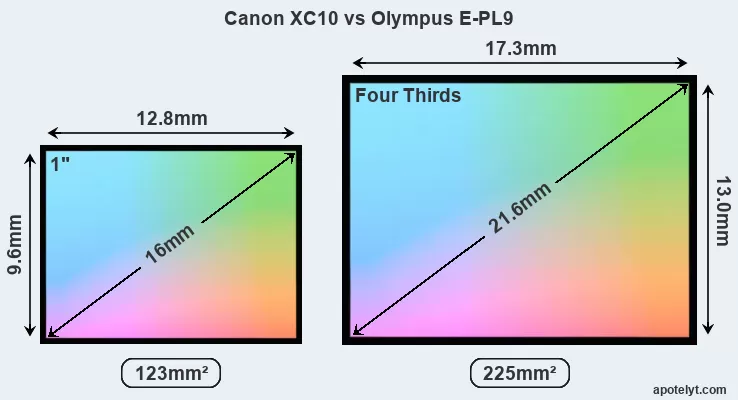
With 15.9MP, the E-PL9 offers a higher resolution than the XC10 (12MP), but the E-PL9 nevertheless has larger individual pixels (pixel pitch of 3.76μm versus 3.20μm for the XC10) due to its larger sensor. Moreover, the E-PL9 is a much more recent model (by 2 years and 10 months) than the XC10, and its sensor will have benefitted from technological advances during this time that further enhance the light gathering capacity of its pixel-units.
The resolution advantage of the Olympus E-PL9 implies greater flexibility for cropping images or the possibility to print larger pictures. The maximum print size of the E-PL9 for good quality output (200 dots per inch) amounts to 23 x 17.3 inches or 58.5 x 43.9 cm, for very good quality (250 dpi) 18.4 x 13.8 inches or 46.8 x 35.1 cm, and for excellent quality (300 dpi) 15.4 x 11.5 inches or 39 x 29.3 cm. The corresponding values for the Canon XC10 are 20 x 15 inches or 50.8 x 38.1 cm for good quality, 16 x 12 inches or 40.6 x 30.5 cm for very good quality, and 13.3 x 10 inches or 33.9 x 25.4 cm for excellent quality prints.
The Canon XC10 has a native sensitivity range from ISO 160 to ISO 20000. The corresponding ISO settings for the Olympus PEN E-PL9 are ISO 200 to ISO 6400, with the possibility to increase the ISO range to 100-25600.
Technology-wise, both cameras are equipped with CMOS (Complementary Metal–Oxide–Semiconductor) sensors. Both cameras use a Bayer filter for capturing RGB colors on a square grid of photosensors. This arrangement is found in most digital cameras.
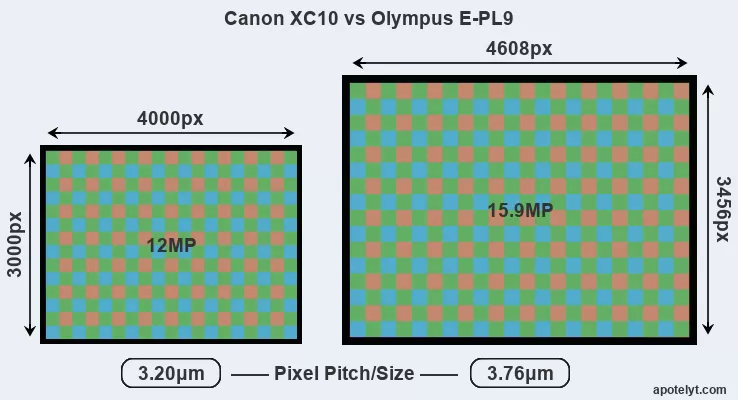
Consistent information on actual sensor performance is available from DXO Mark for many cameras. This service is based on lab testing and assigns an overall score to each camera sensor, as well as ratings for dynamic range ("DXO Landscape"), color depth ("DXO Portrait"), and low-light sensitivity ("DXO Sports"). The adjacent table reports on the physical sensor characteristics and the outcomes of the DXO sensor quality tests for a sample of comparator-cameras.

| # | Camera Model |
Sensor Class |
Resolution (MP) |
Horiz. Pixels |
Vert. Pixels |
Video Format |
DXO Portrait |
DXO Landscape |
DXO Sports |
DXO Overall |
|
|---|---|---|---|---|---|---|---|---|---|---|---|
| 1. | Canon XC10 | 1-inch | 12.0 | 4000 | 3000 | 4K/30p | 21.7 | 11.8 | 197 | 61 | |
| 2. | Olympus E-PL9 | Four Thirds | 15.9 | 4608 | 3456 | 4K/30p | 23.1 | 12.8 | 1162 | 74 | |
| 3. | Canon G7 X Mark II | 1-inch | 20.0 | 5472 | 3648 | 1080/60p | 21.8 | 11.9 | 260 | 62 | |
| 4. | Canon G5 X | 1-inch | 20.0 | 5472 | 3648 | 1080/60p | 21.4 | 12.3 | 471 | 62 | |
| 5. | Canon G9 X | 1-inch | 20.0 | 5472 | 3648 | 1080/60p | 21.5 | 12.3 | 495 | 63 | |
| 6. | Canon G1 X Mark II | 1.5-inch | 13.0 | 4160 | 3120 | 1080/30p | 21.5 | 10.8 | 581 | 58 | |
| 7. | Canon G7 X | 1-inch | 20.0 | 5472 | 3648 | 1080/60p | 23.0 | 12.7 | 556 | 71 | |
| 8. | Canon SX60 | 1/2.3 | 14.2 | 4608 | 3072 | 1080/60p | 19.2 | 10.8 | 127 | 39 | |
| 9. | Fujifilm X30 | 2/3 | 12.0 | 4000 | 3000 | 1080/60p | 20.4 | 11.2 | -312 | 49 | |
| 10. | Nikon P900 | 1/2.3 | 15.9 | 4608 | 3456 | 1080/60p | 20.2 | 11.6 | 727 | 47 | |
| 11. | Olympus E-PL10 | Four Thirds | 15.9 | 4608 | 3456 | 4K/30p | 23.3 | 13.1 | 1324 | 76 | |
| 12. | Olympus E-M10 III | Four Thirds | 15.9 | 4608 | 3456 | 4K/30p | 23.1 | 12.8 | 1120 | 74 | |
| 13. | Olympus E-PL8 | Four Thirds | 15.9 | 4608 | 3456 | 1080/30p | 23.0 | 12.6 | 1030 | 73 | |
| 14. | Olympus E-M10 II | Four Thirds | 15.9 | 4608 | 3456 | 1080/60p | 23.1 | 12.5 | 842 | 73 | |
| 15. | Olympus E-M10 | Four Thirds | 15.9 | 4608 | 3456 | 1080/30p | 22.8 | 12.3 | 884 | 72 | |
| 16. | Panasonic FZ2500 | 1-inch | 20.0 | 5472 | 3648 | 4K/30p | 23.0 | 12.6 | 538 | 70 | |
| 17. | Panasonic LX100 | Four Thirds | 12.7 | 4112 | 3088 | 4K/30p | 22.3 | 12.5 | 553 | 67 | |
| Note: DXO values in italics represent estimates based on sensor size and age. | |||||||||||
Many modern cameras are not only capable of taking still images, but also of capturing video footage. The two cameras under consideration both have sensors whose read-out speed is fast enough to capture moving pictures, and both provide the same movie specifications (4K/30p).
Feature comparison
Beyond body and sensor, cameras can and do differ across a range of features. The XC10 and the E-PL9 are similar in the sense that neither of the two has a viewfinder. The images are, thus, framed using live view on the rear LCD. The table below summarizes some of the other core capabilities of the Canon XC10 and Olympus E-PL9 in connection with corresponding information for a sample of similar cameras.

| # | Camera Model |
Viewfinder (Type or 000 dots) |
Control Panel (yes/no) |
LCD Specifications (inch/000 dots) |
LCD Attach- ment |
Touch Screen (yes/no) |
Max Shutter Speed * |
Max Shutter Flaps * |
Built-in Flash (yes/no) |
Built-in Image Stab |
|
|---|---|---|---|---|---|---|---|---|---|---|---|
| 1. | Canon XC10 | none | n | 3.0 / 1030 | tilting | Y | 1/2000s | 3.8/s | n | Y | |
| 2. | Olympus E-PL9 | none | n | 3.0 / 1040 | tilting | Y | 1/4000s | 8.6/s | Y | Y | |
| 3. | Canon G7 X Mark II | none | n | 3.0 / 1040 | tilting | Y | 1/2000s | 8.0/s | Y | Y | |
| 4. | Canon G5 X | 2360 | n | 3.0 / 1040 | swivel | Y | 1/2000s | 5.9/s | Y | Y | |
| 5. | Canon G9 X | none | n | 3.0 / 1040 | fixed | Y | 1/2000s | 6.0/s | Y | Y | |
| 6. | Canon G1 X Mark II | optional | n | 3.0 / 1040 | tilting | Y | 1/4000s | 5.2/s | Y | Y | |
| 7. | Canon G7 X | none | n | 3.0 / 1040 | tilting | Y | 1/2000s | 6.5/s | Y | Y | |
| 8. | Canon SX60 | 922 | n | 3.0 / 922 | swivel | n | 1/2000s | 6.4/s | Y | Y | |
| 9. | Fujifilm X30 | 2360 | n | 3.0 / 920 | tilting | n | 1/4000s | 12.0/s | Y | Y | |
| 10. | Nikon P900 | 921 | n | 3.0 / 921 | swivel | n | 1/4000s | 7.0/s | Y | Y | |
| 11. | Olympus E-PL10 | none | n | 3.0 / 1040 | tilting | Y | 1/4000s | 8.6/s | Y | Y | |
| 12. | Olympus E-M10 III | 2360 | n | 3.0 / 1040 | tilting | Y | 1/4000s | 8.6/s | Y | Y | |
| 13. | Olympus E-PL8 | optional | n | 3.0 / 1037 | tilting | Y | 1/4000s | 8.0/s | n | Y | |
| 14. | Olympus E-M10 II | 2360 | n | 3.0 / 1040 | tilting | Y | 1/4000s | 8.0/s | Y | Y | |
| 15. | Olympus E-M10 | 1440 | n | 3.0 / 1037 | tilting | Y | 1/4000s | 8.0/s | Y | Y | |
| 16. | Panasonic FZ2500 | 2360 | n | 3.0 / 1040 | swivel | Y | 1/4000s | 12.0/s | Y | Y | |
| 17. | Panasonic LX100 | 2764 | n | 3.0 / 921 | fixed | n | 1/4000s | 11.0/s | n | Y | |
| Note: *) Information refers to the mechanical shutter, unless the camera only has an electronic one. | |||||||||||
One difference between the cameras concerns the presence of an on-board flash. The E-PL9 has one, while the XC10 does not. While the built-in flash of the E-PL9 is not very powerful, it can at times be useful as a fill-in light.
The E-PL9 has an articulated screen that can be turned to be front-facing. This characteristic will be appreciated by vloggers and photographers who are interested in taking selfies. In contrast, the XC10 does not have a selfie-screen.The reported shutter speed information refers to the use of the mechanical shutter. Yet, some cameras only have an electronic shutter, while others have an electronic shutter in addition to a mechanical one. In fact, the E-PL9 is one of those camera that have an additional electronic shutter, which makes completely silent shooting possible. However, this mode is less suitable for photographing moving objects (risk of rolling shutter) or shooting under artificial light sources (risk of flickering).
The Canon XC10 and the Olympus E-PL9 both have an intervalometer built-in. This enables the photographer to capture time lapse sequences, such as flower blooming, a sunset or moon rise, without purchasing an external camera trigger and related software.
The XC10 writes its imaging data to CFast or SDXC cards, while the E-PL9 uses SDXC cards. The XC10 features dual card slots, which can be very useful in case a memory card fails. In contrast, the E-PL9 only has one slot. Both cameras can use UHS-I cards, which provide for Ultra High Speed data transfer of up to 104 MB/s.
Connectivity comparison
For some imaging applications, the extent to which a camera can communicate with its environment can be an important aspect in the camera decision process. The table below provides an overview of the connectivity of the Canon XC10 and Olympus PEN E-PL9 and, in particular, the interfaces the cameras (and selected comparators) provide for accessory control and data transfer.

| # | Camera Model |
Hotshoe Port |
Internal Mic / Speaker |
Microphone Port |
Headphone Port |
HDMI Port |
USB Port |
WiFi Support |
NFC Support |
Bluetooth Support |
|
|---|---|---|---|---|---|---|---|---|---|---|---|
| 1. | Canon XC10 | Y | stereo / mono | Y | Y | mini | 2.0 | Y | Y | - | |
| 2. | Olympus E-PL9 | Y | stereo / mono | - | - | micro | 2.0 | Y | - | Y | |
| 3. | Canon G7 X Mark II | - | stereo / mono | - | - | micro | 2.0 | Y | Y | - | |
| 4. | Canon G5 X | Y | stereo / mono | - | - | mini | 2.0 | Y | Y | - | |
| 5. | Canon G9 X | - | stereo / mono | - | - | micro | 2.0 | Y | Y | - | |
| 6. | Canon G1 X Mark II | Y | stereo / mono | - | - | mini | 2.0 | Y | Y | - | |
| 7. | Canon G7 X | - | stereo / mono | - | - | micro | 2.0 | Y | Y | - | |
| 8. | Canon SX60 | Y | stereo / mono | Y | - | mini | 2.0 | Y | Y | - | |
| 9. | Fujifilm X30 | Y | stereo / mono | - | - | micro | 2.0 | Y | - | - | |
| 10. | Nikon P900 | - | stereo / mono | - | - | micro | 2.0 | Y | Y | - | |
| 11. | Olympus E-PL10 | Y | stereo / mono | - | - | micro | 2.0 | Y | - | Y | |
| 12. | Olympus E-M10 III | Y | stereo / mono | - | - | micro | 2.0 | Y | - | - | |
| 13. | Olympus E-PL8 | Y | stereo / mono | - | - | micro | 2.0 | Y | - | - | |
| 14. | Olympus E-M10 II | Y | stereo / mono | - | - | micro | 2.0 | Y | - | - | |
| 15. | Olympus E-M10 | Y | stereo / mono | - | - | micro | 2.0 | Y | - | - | |
| 16. | Panasonic FZ2500 | Y | stereo / mono | Y | Y | micro | 2.0 | Y | - | - | |
| 17. | Panasonic LX100 | Y | stereo / mono | - | - | micro | 2.0 | Y | Y | - |
It is notable that the XC10 has a microphone port, which is missing on the E-PL9. Such an external microphone input can help to substantially improve the quality of audio recordings when a good external microphone is used.
Both the XC10 and the E-PL9 have been discontinued, but can regularly be found used on ebay. The XC10 was replaced by the Canon XC15, while the E-PL9 was followed by the Olympus E-PL10. Further information on the features and operation of the XC10 and E-PL9 can be found, respectively, in the Canon XC10 Manual (free pdf) or the online Olympus E-PL9 Manual.
Review summary
So what conclusions can be drawn? Which of the two cameras – the Canon XC10 or the Olympus E-PL9 – has the upper hand? Is one clearly better than the other? Below is a summary of the relative strengths of each of the two contestants.

Advantages of the Canon XC10:
- Better sound: Can connect to an external microphone for higher quality sound recording.
- Better sound control: Has a headphone port that enables audio monitoring while recording.
- Ready to shoot: Has a lens built-in, whereas the E-PL9 requires a separate lens.
- Easier travel charging: Can be conveniently charged via its USB port.
- Easier device pairing: Supports NFC for fast wireless image transfer over short distances.
- Greater peace of mind: Features a second card slot as a backup in case of memory card failure.
- More heavily discounted: Has been available for much longer (launched in April 2015).

Reasons to prefer the Olympus PEN E-PL9:
- More detail: Has more megapixels (15.9 vs 12MP), which boosts linear resolution by 15%.
- Better image quality: Is equipped with a larger and more technologically advanced sensor.
- Richer colors: The sensor size advantage translates into images with better, more accurate colors.
- More dynamic range: Larger sensor captures a wider spectrum of light and dark details.
- Better low-light sensitivity: Larger sensor produces good images even in poorly lit environments.
- More selfie-friendly: Has an articulated screen that can be turned to be front-facing.
- Faster shutter: Has higher mechanical shutter speed (1/4000s vs 1/2000s) to freeze action.
- Faster burst: Shoots at higher frequency (8.6 vs 3.8 flaps/sec) to capture the decisive moment.
- Less disturbing: Has an electronic shutter option for completely silent shooting.
- More flexible: Takes interchangeable lenses and can thus be used with specialty optics.
- More compact: Is smaller (117x68mm vs 125x102mm) and will fit more readily into a bag.
- Easier fill-in: Has a small integrated flash to brighten shadows of backlit subjects.
- Easier wireless transfer: Supports Bluetooth for image sharing without cables.
- More modern: Reflects 2 years and 10 months of technical progress since the XC10 launch.
If the count of individual advantages (bullet points above) is taken as a guide, the E-PL9 is the clear winner of the contest (14 : 7 points). However, the pertinence of the various camera strengths will differ across photographers, so that you might want to weigh individual camera traits according to their importance for your own imaging needs before making a camera decision. A professional wedding photographer will view the differences between cameras in a way that diverges from the perspective of a travel photog, and a person interested in cityscapes has distinct needs from a macro shooter. Hence, the decision which camera is best and worth buying is often a very personal one.
How about other alternatives? Do the specifications of the Canon XC10 and the Olympus E-PL9 place the cameras among the top in their class? Find out in the latest Best Superzoom Camera and Best Mirrorless Interchangeable Lens Camera listings whether the two cameras rank among the cream of the crop.
In any case, while the specs-based evaluation of cameras can be instructive in revealing their potential as photographic tools, it says little about, for example, the shooting experience and imaging performance of the XC10 and the E-PL9 in practical situations. User reviews, such as those found at amazon, can sometimes inform about these issues, but such feedback is often incomplete, inconsistent, and biased.
Expert reviews
This is where reviews by experts come in. The table below provides a synthesis of the camera assessments of some of the best known photo-gear review sites (amateurphotographer [AP], cameralabs [CL], digitalcameraworld [DCW], dpreview [DPR], ephotozine [EPZ], photographyblog [PB]). As can be seen, the professional reviewers agree in many cases on the quality of different cameras, but sometimes their assessments diverge, reinforcing the earlier point that a camera decision is often a very personal choice.

| # | Camera Model |
AP score |
CL score |
DCW score |
DPR score |
EPZ score |
PB score |
Camera Launch |
Launch Price (USD) |
Street Price |
|
|---|---|---|---|---|---|---|---|---|---|---|---|
| 1. | Canon XC10 | .. | .. | .. | 80/100 | .. | .. | Apr 2015 | 2,499 | ebay.com | |
| 2. | Olympus E-PL9 | .. | + | .. | .. | 4.5/5 | 4/5 | Feb 2018 | 599 | ebay.com | |
| 3. | Canon G7 X Mark II | 4.5/5 | + + | .. | 81/100 | 4.5/5 | 4.5/5 | Feb 2016 | 699 | ebay.com | |
| 4. | Canon G5 X | 5/5 | + + | .. | 78/100 | 4.5/5 | 4.5/5 | Oct 2015 | 799 | ebay.com | |
| 5. | Canon G9 X | 3.5/5 | + + | .. | .. | 4.5/5 | 4.5/5 | Oct 2015 | 529 | ebay.com | |
| 6. | Canon G1 X Mark II | 3/5 | + | .. | 77/100 | 4/5 | 4.5/5 | Feb 2014 | 799 | ebay.com | |
| 7. | Canon G7 X | 4/5 | + + | .. | 77/100 | 4.5/5 | 4.5/5 | Sep 2014 | 699 | ebay.com | |
| 8. | Canon SX60 | 3/5 | + + | .. | 75/100 | 4/5 | 4.5/5 | Sep 2014 | 549 | ebay.com | |
| 9. | Fujifilm X30 | 4/5 | .. | .. | 76/100 | 4.5/5 | 4.5/5 | Aug 2014 | 599 | ebay.com | |
| 10. | Nikon P900 | .. | .. | .. | 77/100 | 4/5 | 4/5 | Mar 2015 | 599 | ebay.com | |
| 11. | Olympus E-PL10 | .. | .. | 4/5 | 77/100 | .. | 4/5 | Oct 2019 | 599 | ebay.com | |
| 12. | Olympus E-M10 III | .. | + | 5/5 | 80/100 | 4.5/5 | 4.5/5 | Aug 2017 | 649 | ebay.com | |
| 13. | Olympus E-PL8 | .. | .. | .. | .. | 4.5/5 | 4/5 | Sep 2016 | 549 | ebay.com | |
| 14. | Olympus E-M10 II | 4.5/5 | + + | .. | 80/100 | 5/5 | 5/5 | Aug 2015 | 649 | ebay.com | |
| 15. | Olympus E-M10 | 4/5 | .. | .. | 80/100 | 5/5 | 5/5 | Jan 2014 | 699 | ebay.com | |
| 16. | Panasonic FZ2500 | .. | + | .. | 82/100 | 4.5/5 | 5/5 | Sep 2016 | 1,199 | amazon.com | |
| 17. | Panasonic LX100 | 5/5 | + + | .. | 85/100 | 5/5 | 5/5 | Sep 2014 | 899 | ebay.com | |
| Note: (+ +) highly recommended; (+) recommended; (o) reviewed; (..) not available. | |||||||||||
Care should be taken when interpreting the review scores above, though. The ratings are only valid when referring to cameras in the same category and of the same age. Thus, a score needs to be put into the context of the launch date and the launch price of the camera, and comparing ratings of very distinct cameras or ones that are far apart in terms of their release date have little meaning. Also, please note that some of the review sites have changed their methodology and reporting over time.

Check XC10 offers at
ebay.com

Check E-PL9 offers at
ebay.com
Other camera comparisons
Did this review help to inform your camera decision process? In case you would like to check on the differences and similarities of other camera models, just use the search menu below. As an alternative, you can also directly jump to any one of the listed comparisons that were previously generated by the CAM-parator tool.
- Canon 200D vs Canon XC10
- Canon M50 Mark II vs Olympus E-PL9
- Canon XC10 vs Fujifilm X30
- Canon XC10 vs Olympus TG-5
- Canon XC10 vs Sony A68
- Canon XC10 vs Sony A99
- Canon XC10 vs Sony RX1R II
- Fujifilm X70 vs Olympus E-PL9
- Leica M10 vs Olympus E-PL9
- Olympus E-PL9 vs Olympus E-PM2
- Olympus E-PL9 vs Panasonic GM1
- Olympus E-PL9 vs Ricoh GR II
Specifications: Canon XC10 vs Olympus E-PL9
Below is a side-by-side comparison of the specs of the two cameras to facilitate a quick review of their differences and common features.
| Camera Model | Canon XC10 | Olympus E-PL9 |
|---|---|---|
| Camera Type | Fixed lens compact camera | Mirrorless system camera |
| Camera Lens | 24-240mm f/2.8-5.6 | Micro Four Thirds lenses |
| Launch Date | April 2015 | February 2018 |
| Launch Price | USD 2,499 | USD 599 |
| Sensor Specs | Canon XC10 | Olympus E-PL9 |
| Sensor Technology | CMOS | CMOS |
| Sensor Format | 1" Sensor | Four Thirds Sensor |
| Sensor Size | 12.8 x 9.6 mm | 17.3 x 13.0 mm |
| Sensor Area | 122.88 mm2 | 224.9 mm2 |
| Sensor Diagonal | 16 mm | 21.6 mm |
| Crop Factor | 2.75x | 2.0x |
| Sensor Resolution | 12 Megapixels | 15.9 Megapixels |
| Image Resolution | 4000 x 3000 pixels | 4608 x 3456 pixels |
| Pixel Pitch | 3.20 μm | 3.76 μm |
| Pixel Density | 9.77 MP/cm2 | 7.08 MP/cm2 |
| Moiré control | Anti-Alias filter | Anti-Alias filter |
| Movie Capability | 4K/30p Video | 4K/30p Video |
| ISO Setting | 160 - 20,000 ISO | 200 - 6,400 ISO |
| ISO Boost | no Enhancement | 100 - 25,600 ISO |
| Image Processor | DIGIC DV5 | TruePic VIII |
| Screen Specs | Canon XC10 | Olympus E-PL9 |
| Viewfinder Type | no viewfinder | no viewfinder |
| LCD Framing | Live View | Live View |
| Rear LCD Size | 3.0inch | 3.0inch |
| LCD Resolution | 1030k dots | 1040k dots |
| LCD Attachment | Tilting screen | Tilting screen |
| Touch Input | Touchscreen | Touchscreen |
| Shooting Specs | Canon XC10 | Olympus E-PL9 |
| Focus System | Contrast-detect AF | Contrast-detect AF |
| Manual Focusing Aid | Focus Peaking | Focus Peaking |
| Max Shutter Speed (mechanical) | 1/2000s | 1/4000s |
| Continuous Shooting | 3.8 shutter flaps/s | 8.6 shutter flaps/s |
| Electronic Shutter | no E-Shutter | up to 1/16000s |
| Time-Lapse Photography | Intervalometer built-in | Intervalometer built-in |
| Image Stabilization | Lens-based stabilization | In-body stabilization |
| Fill Flash | no On-Board Flash | Built-in Flash |
| Storage Medium | CFAST or SDXC cards | SDXC cards |
| Single or Dual Card Slots | Dual card slots | Single card slot |
| UHS card support | UHS-I | UHS-I |
| Connectivity Specs | Canon XC10 | Olympus E-PL9 |
| External Flash | Hotshoe | Hotshoe |
| USB Connector | USB 2.0 | USB 2.0 |
| HDMI Port | mini HDMI | micro HDMI |
| Microphone Port | External MIC port | no MIC socket |
| Headphone Socket | Headphone port | no Headphone port |
| Wifi Support | Wifi built-in | Wifi built-in |
| Near-Field Communication | NFC built-in | no NFC |
| Bluetooth Support | no Bluetooth | Bluetooth built-in |
| Body Specs | Canon XC10 | Olympus E-PL9 |
| Battery Type | Canon LP-E6N | Olympus BLS-50 |
| Battery Life (CIPA) | 370 shots per charge | 350 shots per charge |
| In-Camera Charging | USB charging | no USB charging |
| Body Dimensions |
125 x 102 x 122 mm (4.9 x 4.0 x 4.8 in) |
117 x 68 x 39 mm (4.6 x 2.7 x 1.5 in) |
| Camera Weight | 1040 g (36.7 oz) | 380 g (13.4 oz) |

Check XC10 offers at
ebay.com

Check E-PL9 offers at
ebay.com
Did you notice an error on this page? If so, please get in touch, so that we can correct the information.

